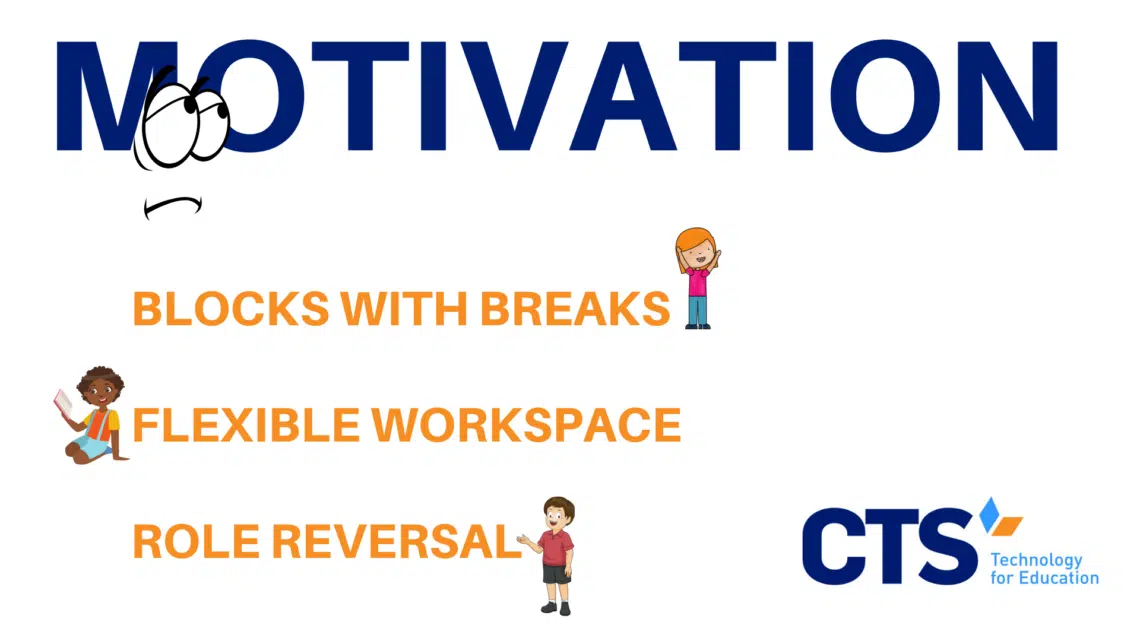Establishing a regular schedule can maintain student motivation during remote learning.
It can be a challenge to stay motivated with remote learning if you’re not used to it. Establishing a regular schedule for each weekday can both simulate the traditional school day and maintain your student’s motivation.
More broadly, families can avoid a weekday free for all by creating blocks of time devoted to specific subject matter or activities. For example, each day can begin by having students set-up their remote learning spaces and gather any needed materials. Afterward, students can check their school email or Google classroom accounts for any messages from their teacher. From there, each day can follow a regular schedule consisting of student work time, as well as periods set aside for lunch, exercise, and pleasure reading.
Ensure your daily schedule includes breaks in student learning.
It’s also vital to build breaks into your student’s day. Doing so can prevent burnout and allow your student to maintain his or her motivation throughout the day and the rest of the week. Schools don’t force students to work constantly, even under normal circumstances, and neither should your remote learning program. Stretch breaks, non-academic technology time, and social video conferencing can provide students with a respite from their academic commitments. Once finished, students can return to their school work feeling refreshed and ready to focus on the day’s assignments.
Allow students a degree of choice in how they choose to learn each day.
Rather than demanding overly prescriptive working styles or studying methods, families can allow students to choose the “how” of their learning process each day. For many students, sitting at a desk or kitchen table isn’t the most natural fit and ultimately decreases productivity, especially if surrounded by other household activities. Similarly, while some students might prefer reading about a particular topic, others may choose to watch a video, create a drawing that illustrates course content, or make flashcards as a means of reviewing their school material. Under challenging circumstances, pedagogical flexibility is key.
Have students teach one another or present their projects to family members.
Without a teacher or group of peers as their audience, some students may lose motivation to produce high-quality academic work. Under remote learning, the social bonds that formed much of a student’s schooling experience are often strained, modifying their education to an almost unrecognizable degree. To counter this, families can set aside time each day for students to present the day’s learning to their siblings or other family members. If there’s already a routine video conference with grandparents or a military family member, that may be an excellent time for a brief presentation.
Reversing the roles, and making the student a teacher in a remote setting institutionalizes the feedback students would normally receive from their teachers during the school day and creates an additional accountability mechanism for students who feel less inclined to complete their assignments while at home. Families can consider adding presentation time to the beginning or end of their student’s daily schedule. Use it to recap the previous day’s learning or share what students have learned by the end of the day. If you can use technology for such a presentation, students may be more likely to take up the mantle of presenter, because it’s fun.
Stay in contact with your child’s teachers and other school staff members.
Although remote instruction can often leave students feeling isolated, many schools still make their teachers and student support staff available for families with questions about classroom content or educational technology. If your student struggles to maintain motivation each day or simply becomes bored with his or her homeschooling routines, teachers can serve as a resource for families seeking to re-engage their students.
If a student becomes discouraged while working on a particular assignment or can’t seem to understand a given concept, families can also contact their child’s teacher to see what help or additional resources are available to support instruction. While it can be tempting for students to procrastinate or give up on a specific assignment during remote instruction, families can leverage their school community’s knowledge to ensure distance learning continues.
Familiarize yourself with your school’s technology—troubleshooting processes to maintain student motivation.
In addition to difficulties with course content, many students encounter technical difficulties that present roadblocks to effective instruction. The longer these issues linger, the less time students spend learning course content. By familiarizing themselves with their school’s technology troubleshooting process, families can quickly resolve technical difficulties and allow their students to continue learning.
These processes typically involve sending an email to a specific school staff member or filling out a survey whose responses flow to the school’s technology team. Having a clear plan in place to resolve technical issues before they arise can save valuable learning time and allow your student to remain on track with his or her studies, even remotely.
At CTS, we’ve supported dozens of schools in creating sustainable, effective remote learning processes that maximize instructional time and eliminate technical headaches. Contact us today to learn more about the technical support we provide, as well as the remote learning resources we’ve developed to support school communities across the country.





